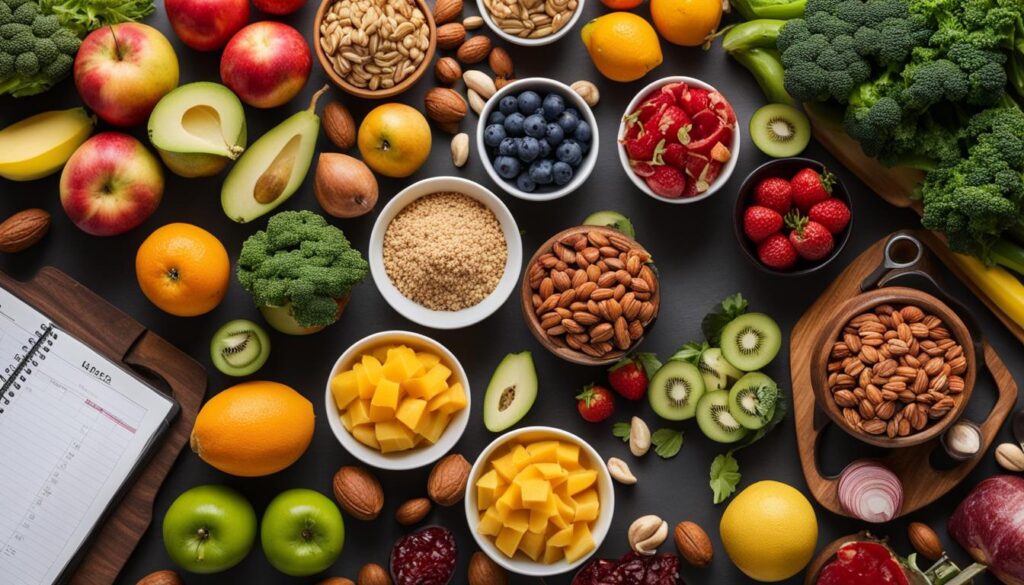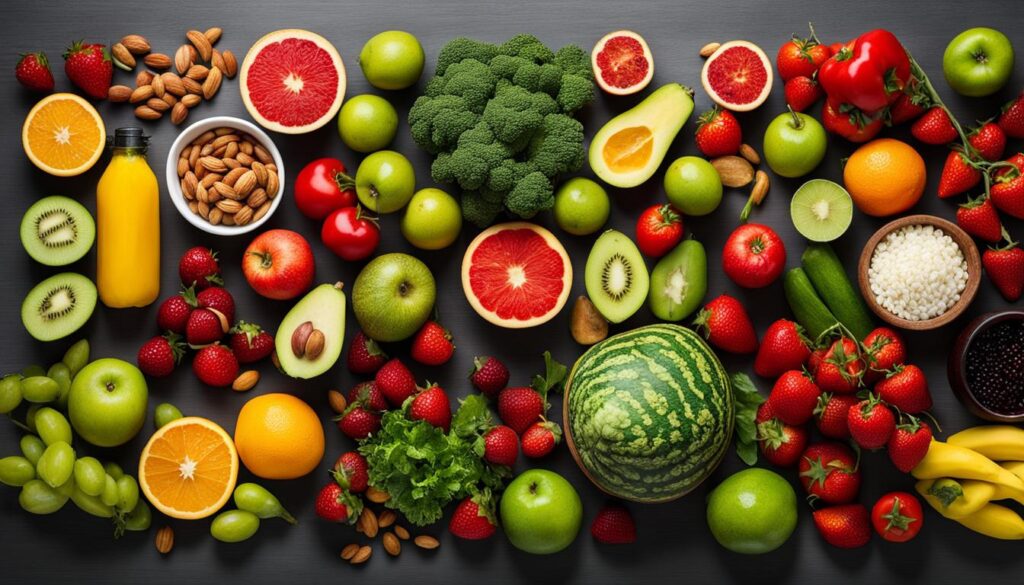Hello, fitness enthusiasts! If you’re looking to shed fat and get in shape, you’ve come to the right place. In this article, I will share optimized fat-burning workout schedules specifically designed for men (check out my post on fat-burning workout here). These workout plans will help you achieve your fat loss goals and build a strong, toned physique in just 12 weeks.
When it comes to burning fat, a combination of effective workout plans and a proper diet is crucial. This fat-burning workout schedule focuses on fat loss, maintaining muscle mass, and improving overall conditioning (check this post out). It provides specific guidelines for training and nutrition, ensuring maximum results.
Are you ready to take your fitness journey to the next level? Let’s dive in and explore the optimized fat-burning workout schedules for men (check this post out).
Key Takeaways:
- Fat-burning workout schedules for men are designed to help you shed fat and build a strong, toned physique in 12 weeks.
- Combining effective workout plans with a proper diet is crucial for fat loss.
- These workout schedules focus on fat loss, maintaining muscle mass, and improving overall conditioning.
- Proper nutrition plays a significant role in achieving fat loss goals.
- Consistency and dedication are key to transforming your body and achieving long-term results.
Goals of the 12-Week Program
In this 12-week program, my primary goals are to help you achieve significant fat loss, maintain or gain lean muscle mass, and improve your overall conditioning. By focusing on these goals, we can help you transform your physique and achieve a higher level of fitness.
To accomplish these goals, we’ll be implementing a well-rounded and progressive workout plan that combines effective fat-burning exercises with muscle-building exercises, along with various conditioning workouts (see my post here). This holistic approach will ensure that we address all aspects of your fitness journey and help you achieve comprehensive results.
Throughout the 12 weeks, we’ll be tracking your progress and making adjustments as needed. Our aim is to promote sustainable fat loss, so we’ll be incorporating nutritional guidelines and lifestyle factors that support long-term success.
Stay committed, follow the program diligently, and trust the process. Let’s work together to transform your body and achieve the goals you’ve set for yourself.
Now, let’s take a look at a table that outlines the key goals of our 12-week program:
| Goals | Description |
|---|---|
| Fat Loss | Achieve a minimum of 10 pounds of fat loss through targeted workouts and a well-balanced diet. |
| Muscle Mass | Maintain or gain lean muscle mass to support a toned and defined physique. |
| Conditioning | Improve overall conditioning and cardiovascular fitness for enhanced endurance and performance. |
12-Week Diet Plan for Men

When it comes to achieving your fitness goals, a well-planned diet plays a crucial role. The 12-week diet plan for men is designed to support your fat loss journey while ensuring you maintain optimal energy levels throughout the program.
During the 12 weeks, you’ll be following a carefully structured eating regimen that consists of three different types of eating days: high carb days, moderate carb days, and low carb days. This variation ensures a balanced approach to your calorie intake and promotes steady fat loss. Let’s take a closer look at each type of eating day:
- High Carb Days: On these days, you’ll consume a higher amount of carbohydrates to fuel your workouts and support muscle recovery. This helps you maintain intensity during training sessions. Examples of high carb foods include quinoa, sweet potatoes, and brown rice.
- Moderate Carb Days: These days provide a balance between high and low carb days. You’ll still include carbohydrates in your meals, but in moderate amounts. Great options include whole wheat bread, oatmeal, and fruits.
- Low Carb Days: On these days, your carbohydrate intake will be significantly reduced. Instead, you’ll focus on consuming lean proteins, healthy fats, and fibrous vegetables. Foods like chicken breast, salmon, avocado, and broccoli are excellent choices.
Calorie intake plays a vital role in your diet plan. It is important to note that calorie needs vary based on age, gender, and activity level. To determine the right calorie intake for you, consult with a qualified nutritionist or dietitian. They will help create a personalized diet plan that aligns with your goals and individual needs.
Protein intake is another crucial aspect of this diet plan. For men, a minimum of 180 grams of protein per day is recommended. Protein plays a vital role in muscle recovery, growth, and satiety. Include high-quality sources of protein such as lean meats, poultry, fish, eggs, and plant-based sources like legumes and tofu.
Fat intake should be approximately 20-30% of your daily calories. Focus on consuming healthy fats, such as those found in nuts, seeds, avocados, olive oil, and fatty fish like salmon. These fats provide essential nutrients and help support hormone production and overall well-being.
Remember, consistency is key when following a diet plan. Stick to your prescribed calorie and macronutrient intake, and make sure to choose nutrient-dense foods that support your overall health and fitness goals.
| Eating Day | Carbohydrate Intake | Protein Intake | Fat Intake |
|---|---|---|---|
| High Carb Days | Higher amount | 180 grams per day | 20-30% of daily calories |
| Moderate Carb Days | Moderate amount | 180 grams per day | 20-30% of daily calories |
| Low Carb Days | Reduced amount | 180 grams per day | 20-30% of daily calories |
“A well-balanced diet plan that aligns with your fitness goals is the foundation for success. By following the 12-week diet plan for men, you’ll optimize your calorie intake, ensure sufficient protein intake, and make smart choices when it comes to consuming fats. Remember, nutrition is key in achieving your desired results.”
12-Week Eating Plan for Women
In the 12-week eating plan for women, we follow a similar approach to the plan designed for men, with slight adjustments in calorie and protein intake based on age and gender. Protein intake is a crucial component of this plan, as it supports muscle growth, repair, and satiety. For women, the minimum protein intake recommended is 100 grams per day.
When it comes to calorie intake, it is important to consider individual needs and goals. Ideally, women should consume the appropriate number of calories to support their activity levels and promote a healthy rate of weight loss. It is recommended to consult with a healthcare professional or registered dietitian to determine the specific calorie intake needed for each individual.
It’s important to note that this eating plan is flexible and can be modified to meet personal preferences and dietary restrictions. However, it is essential to maintain a balanced and nutritious diet throughout the 12 weeks to ensure optimal results.
Protein is an essential macronutrient for women, as it helps maintain muscle mass, supports recovery, and provides a sense of fullness. Including a variety of protein-rich foods in your diet, such as lean meats, poultry, fish, dairy products, legumes, and tofu, can help meet your protein needs and support your fitness journey.
Sample Meal Plan
Below is a sample meal plan for a day, which can be adjusted and customized according to individual preferences and dietary requirements:
| Meal | Time | Food Choices |
|---|---|---|
| Breakfast | 8:00 AM | Scrambled eggs with vegetables, whole wheat toast, and a side of Greek yogurt |
| Snack | 10:00 AM | Protein shake with fruits and nuts |
| Lunch | 12:30 PM | Grilled chicken breast with quinoa and roasted vegetables |
| Snack | 3:00 PM | Greek yogurt with berries and a sprinkle of granola |
| Dinner | 6:30 PM | Salmon fillet with steamed broccoli and brown rice |
| Snack | 9:00 PM | Veggies with hummus |
Remember, this is just a sample, and you can modify the meal plan according to your taste preferences and nutritional needs. It’s important to focus on consuming whole, nutrient-dense foods and maintaining a calorie deficit to support your weight loss goals.
12-Week Cardio Plan

Incorporating a well-rounded cardio plan into your 12-week workout program is crucial for maximizing fat-burning and improving overall cardiovascular fitness. In this section, I will outline a comprehensive cardio plan designed to gradually increase intensity and duration over the course of the program.
Cardiovascular exercises, also known as cardio, are effective in burning calories and boosting your metabolism. They can be performed using various equipment and methods, allowing you to choose what works best for you.
High-Intensity Interval Training (HIIT)
One highly effective form of cardio is High-Intensity Interval Training (HIIT). This involves alternating bursts of intense activity with short periods of rest or low-intensity exercise. HIIT is known to burn more calories in a shorter amount of time compared to steady-state cardio.
Example:
Perform a 30-second sprint on the treadmill at maximum effort, followed by a 60-second slow jog to recover. Repeat this cycle for a total of 10 minutes.
Variety is Key
To keep your cardio workouts engaging and prevent boredom, it’s important to incorporate a variety of exercises. This can include running, cycling, swimming, using the elliptical machine, or participating in group fitness classes.
Example:
- Monday: 30-minute outdoor run
- Wednesday: 45-minute cycling class
- Friday: 20-minute swimming session
Rest Days
Rest days are an essential part of any workout program, including the cardio plan. They allow your body to recover and repair, reducing the risk of injury and ensuring optimal results.
On rest days, it’s important to still stay active, but not engage in high-intensity exercises. Instead, focus on light walking, stretching, or yoga to promote blood flow and flexibility.
Sample 12-Week Cardio Plan Schedule
| Week | Cardio Schedule |
|---|---|
| 1-3 | 3 days of cardio per week (e.g., 20 minutes of HIIT) |
| 4-6 | 4 days of cardio per week (e.g., 30 minutes of steady-state cardio) |
| 7-9 | 5 days of cardio per week (e.g., 40 minutes of a combination of HIIT and steady-state cardio) |
| 10-12 | 5-6 days of cardio per week (e.g., 45 minutes of a variety of cardio exercises) |
Remember, consistency is key when it comes to the cardio plan. Gradually increasing the intensity and duration of your workouts will help you achieve your fat-burning goals while allowing enough rest for recovery. Stick to the schedule, and you’ll be well on your way to a stronger, fitter, and healthier you.
12-Week Gym Workout Split

In this section, I will outline the 12-week gym workout split that will guide your fitness journey. By following this workout plan, you’ll target different muscle groups and progressively increase intensity to maximize your results. Let’s dive in!
Upper/Lower Split
The 12-week gym workout split utilizes an upper/lower split training approach. This means your workouts will be divided into two main categories: upper body exercises and lower body exercises. By separating these muscle groups, you’ll be able to focus on specific areas while allowing for adequate rest and recovery.
Here’s a breakdown of how the weekly workout split looks:
| Day | Focus |
|---|---|
| Monday | Upper Body |
| Tuesday | Lower Body |
| Wednesday | Rest |
| Thursday | Upper Body |
| Friday | Lower Body |
| Saturday | Rest |
| Sunday | Rest |
This alternating pattern ensures that you give equal attention to your upper and lower body while allowing for adequate rest days. Remember, rest is crucial for muscle recovery and growth.
Exercise Selection and Rep Schemes
Each workout day will include a variety of exercises targeting specific muscle groups. Here’s a sample workout plan for upper body and lower body days:
Upper Body Workout:
- Bench Press – 3 sets of 8-10 reps
- Lat Pulldown – 3 sets of 10-12 reps
- Shoulder Press – 3 sets of 8-10 reps
- Bicep Curls – 3 sets of 10-12 reps
- Tricep Dips – 3 sets of 8-10 reps
- Squats – 3 sets of 8-10 reps
- Deadlifts – 3 sets of 6-8 reps
- Lunges – 3 sets of 10-12 reps
- Leg Press – 3 sets of 8-10 reps
- Calf Raises – 3 sets of 12-15 reps
The rep schemes mentioned above serve as a guideline to help you track your progress. However, you can adjust the number of reps and sets based on your fitness level and comfort. It’s important to challenge yourself while maintaining proper form throughout each exercise.
Remember, consistency is key to achieving your fitness goals. Stick to the 12-week gym workout split and gradually increase the weight and intensity as you progress. Your hard work and dedication will pay off!
Mindset and Sleep

A positive mindset and adequate sleep play crucial roles in achieving fat loss goals. It’s not just about following a strict diet and exercise routine; your mentality and sleep patterns greatly impact your body’s ability to burn fat and maintain hormonal balance. Let’s explore how mindset and sleep can influence your weight loss journey.
Maintaining a Positive Mindset
Your mindset determines your attitude towards challenges and setbacks during your fat loss journey. By adopting a positive mindset, you empower yourself with the belief that you can overcome any obstacle and achieve your goals. A strong mental state helps you stay motivated, committed, and focused on making sustainable lifestyle changes.
Remember, setbacks are normal, but not letting them deter you is what sets you apart. Embrace each day as an opportunity to make progress and build healthy habits. Encourage yourself and cultivate self-compassion throughout your journey. Remember, change takes time, so be patient and persistent with yourself.
The Importance of Quality Sleep
Sleep plays a vital role in regulating your hormones and maintaining a healthy weight. When you consistently get 6-8 hours of quality sleep each night, your body functions optimally, allowing your hormones to stay balanced and support fat loss.
During sleep, your body repairs and replenishes itself. Lack of sleep can disrupt hormonal balance, leading to increased levels of ghrelin, the hormone that stimulates appetite, and decreased levels of leptin, the hormone responsible for making you feel full. This hormonal imbalance can result in cravings and overeating, hindering your weight loss progress.
Additionally, sleep deprivation can lead to increased stress levels, which trigger the release of cortisol, a hormone that promotes fat storage, particularly in the abdominal area.
To ensure a good night’s sleep, establish a relaxing bedtime routine, create a comfortable sleep environment, and limit exposure to electronic devices before bed. Prioritize sleep as an essential part of your fat loss journey.
| Sleep Recommendations for Adults |
|---|
| Age 18-64: 7-9 hours per night |
| Age 65+: 7-8 hours per night |
Quality sleep is not only important for your physical health but also for your mental well-being. It helps enhance cognitive function, mood, and overall productivity, allowing you to approach your fat loss goals with clarity and focus.
Embrace a positive mindset and prioritize getting sufficient sleep to optimize your fat loss journey. The combination of a determined mindset and quality sleep will support hormonal balance, reduce cravings, and enhance your overall well-being.
Nutrition and Healthy Snacks

Proper nutrition plays a crucial role in achieving successful fat loss. By following a balanced diet that includes whole foods and maintaining a slight calorie deficit, you can effectively support your weight loss goals. But did you know that incorporating healthy snacks into your diet can provide additional nutrients and support your workout plan?
When it comes to nutrition, it’s important to focus on consuming nutrient-dense foods that nourish your body while keeping you satisfied. Opt for whole grains, lean proteins, fruits, vegetables, and healthy fats to provide your body with the necessary nutrients for optimal function and recovery.
However, it’s just as important to take into account portion sizes and the overall calorie intake. Even when aiming for a calorie deficit, it’s crucial to meet your daily nutritional needs and avoid severe deprivation. This sustainable approach ensures that you’re providing your body with the right amount of energy to fuel your workouts and promote overall well-being.
Now, let’s talk about healthy snacks. Snacking can be a part of a balanced diet, as long as you make wise choices. Opt for snacks that are low in added sugars, unhealthy fats, and high in nutrients. Filling your pantry with options like fresh fruits, vegetables, nuts, seeds, and Greek yogurt can help curb cravings between meals and provide a nutrient boost.
“Eating healthy snacks throughout the day can help keep hunger at bay and prevent overeating during meals,” says nutrition expert Dr. Sarah Johnson.
Additionally, incorporating healthy snacks into your nutrition plan can help maintain stable blood sugar levels, keep your metabolism revved up, and support muscle recovery.
Remember, while healthy snacks can provide valuable nutrition, it’s important to remain mindful of portion sizes. Snacks should be consumed in moderation and fit within your overall calorie and macronutrient goals.
By prioritizing proper nutrition and incorporating healthy snacks into your diet, you can fuel your body with the essential nutrients it needs, maintain a calorie deficit, and support your workout plan for optimal fat loss results.
Key Takeaways
- Proper nutrition is crucial for successful fat loss.
- A balanced diet that includes whole foods and maintains a slight calorie deficit supports weight loss goals.
- Healthy snacks can provide additional nutrients and support your workout plan.
- Focus on consuming nutrient-dense foods while monitoring portion sizes and overall calorie intake.
- Incorporate snacks that are low in added sugars and unhealthy fats, and high in nutrients.
- Snacking can help maintain stable blood sugar levels, support metabolism, and aid in muscle recovery.
- Remember to consume snacks in moderation and ensure they align with your overall calorie and macronutrient goals.
Types of Exercises for Fat Burning

When it comes to burning calories and melting away fat, incorporating both cardio exercise and strength training into your workout routine is essential. Cardio exercises are excellent for increasing your heart rate and burning calories, while strength training exercises help build lean muscle mass and boost your metabolism for even greater fat burning.
The Benefits of Cardio Exercise
Cardio exercises, also known as cardiovascular or aerobic exercises, are any form of physical activity that raises your heart rate. These exercises help improve cardiovascular health, increase lung capacity, and burn a significant number of calories. Here are some popular forms of cardio exercise:
- Running: Whether you prefer outdoor jogging or using a treadmill, running is a fantastic way to burn calories and improve your cardiovascular fitness.
- Cycling: Whether it’s cycling outdoors or hitting the spin bike at the gym, cycling is a low-impact cardio exercise that targets the lower body while burning calories.
- Swimming: Swimming is a full-body workout that engages multiple muscle groups, providing a great cardio workout while being gentle on the joints.
- High-Intensity Interval Training (HIIT): HIIT workouts involve short bursts of intense exercise alternated with active recovery periods. This type of cardio training maximizes calorie burn and improves endurance.
The Power of Strength Training
Strength training exercises involve working your muscles against resistance, such as weights or your bodyweight. These exercises help build lean muscle mass, sculpt your physique, and increase your metabolism. Here are some effective strength training exercises:
- Squats: Squats target the muscles in your legs, particularly your quadriceps, hamstrings, and glutes. They also engage your core for stability and strength.
- Deadlifts: Deadlifts are a compound exercise that targets multiple muscle groups, including your back, glutes, hamstrings, and core. They help build overall strength and stability.
- Bench Press: The bench press is a classic exercise for targeting the muscles in your chest, shoulders, and triceps. It helps develop upper body strength and muscle definition.
- Plank: The plank is a dynamic core exercise that engages your abdominal muscles, lower back, and shoulders. It helps improve core stability and overall body strength.
By combining cardio exercises and strength training in your workout routine, you can maximize fat burning and achieve a toned and lean physique. Remember to consult with a fitness professional to create a personalized exercise plan that suits your fitness level and goals.
Can High-Intensity Interval Training be Incorporated into a Fat-Burning Workout Schedule for Men?
High-intensity interval training, or HIIT, can definitely be incorporated into a fat-burning workout schedule for men. By including HIIT workouts, men can effectively burn fat fast with HIIT while building strength and endurance (check out my post on burn fat fast here). It’s a challenging yet effective way to see quick results in fat loss and muscle definition.
Training Frequency and Rest Days

When it comes to your fitness journey, training frequency and rest days play a crucial role in maximizing your results. While it is ideal to train every day, the duration of each session should be adjusted based on your time availability and fitness level.
Training frequency refers to how often you engage in physical activity. Consistency is key, as regular exercise helps build strength, endurance, and overall fitness. However, overtraining without allowing sufficient rest can lead to muscle fatigue, decreased performance, and an increased risk of injury.
That’s where rest days come in. Rest days provide your muscles with the necessary time and space to recover and repair themselves after intense workouts. During rest days, your body replenishes energy stores, reduces inflammation, and promotes muscle growth. It is during this recovery phase that your muscles adapt and become stronger.
The number of rest days needed per week can vary depending on your fitness level and training intensity. As a general guideline, most people benefit from at least one or two rest days per week. These rest days can be used for light activity such as stretching, yoga, or gentle walks to promote blood flow and aid in muscle recovery.
A balanced training schedule that incorporates both training days and rest days ensures optimal muscle recovery and prevents overtraining. Over time, this balanced approach can help you avoid plateaus and continue making progress toward your fitness goals.
Remember, muscle recovery is crucial for long-term progress, and neglecting rest days can hinder your overall performance. So, listen to your body, prioritize rest, and give yourself the time needed to recover and grow stronger.
Benefits of Rest Days
- Promotes muscle repair and growth
- Reduces the risk of overuse injuries
- Prevents mental and physical burnout
- Restores energy levels and reduces fatigue
- Allows time for other activities and hobbies
Tips for Training Frequency
- Start with a manageable training schedule and gradually increase intensity and duration over time.
- Listen to your body and adjust your training frequency based on how you feel. If you’re consistently feeling exhausted or experiencing pain, it may be a sign that you need more rest.
- Include a combination of cardiovascular exercise, strength training, and flexibility workouts in your routine for a well-rounded approach to fitness.
- Consider working with a qualified fitness professional who can help design a personalized training program that suits your specific needs and goals.
Boosting Workout Results
When it comes to achieving optimal workout results, incorporating varied exercise routines and increasing resistance are key. By challenging your body with different exercises and pushing its limits, you can boost calorie burn, increase strength, and accelerate weight loss.
One effective strategy is to regularly change up your exercise routines. This not only keeps your workouts exciting and prevents boredom, but it also helps prevent plateauing. When your body becomes accustomed to a particular exercise, it becomes more efficient at performing it. By introducing new exercises, you shock your muscles and force them to adapt, leading to improved gains in strength and endurance.
Additionally, increasing resistance during your workouts is essential for making progress. Whether you’re lifting weights, using resistance bands, or performing bodyweight exercises, gradually increasing the load or intensity will challenge your muscles and make them stronger. This increased resistance stimulates muscle growth and boosts overall calorie burn, even at rest.
Conclusion
After 12 weeks of dedicated effort, I have successfully achieved my fat loss goals and undergone a remarkable body transformation. This journey has taught me the importance of committing to a long-term solution that combines proper nutrition, regular exercise, and a positive mindset.
By following this fat-burning workout plan, I have not only lost excess fat but also improved my overall health and well-being (see my post here). The structured approach provided in this program has been instrumental in keeping me on track and motivated throughout the entire journey.
Through consistent adherence to the 12-week diet plan, cardio plan, and gym workout split, I have witnessed significant changes in my physique. My body fat percentage has dropped, and my muscle definition has become more pronounced. I am proud of the progress I have made and excited to continue my fitness journey.
In conclusion, achieving long-term fat loss and undergoing a body transformation requires discipline, consistency, and a positive mindset. This fat-burning workout plan has provided me with the tools and guidance necessary to reach my goals (see my post here). I am confident that by staying committed to this lifestyle, I will continue to see positive changes and maintain my newfound level of fitness.




